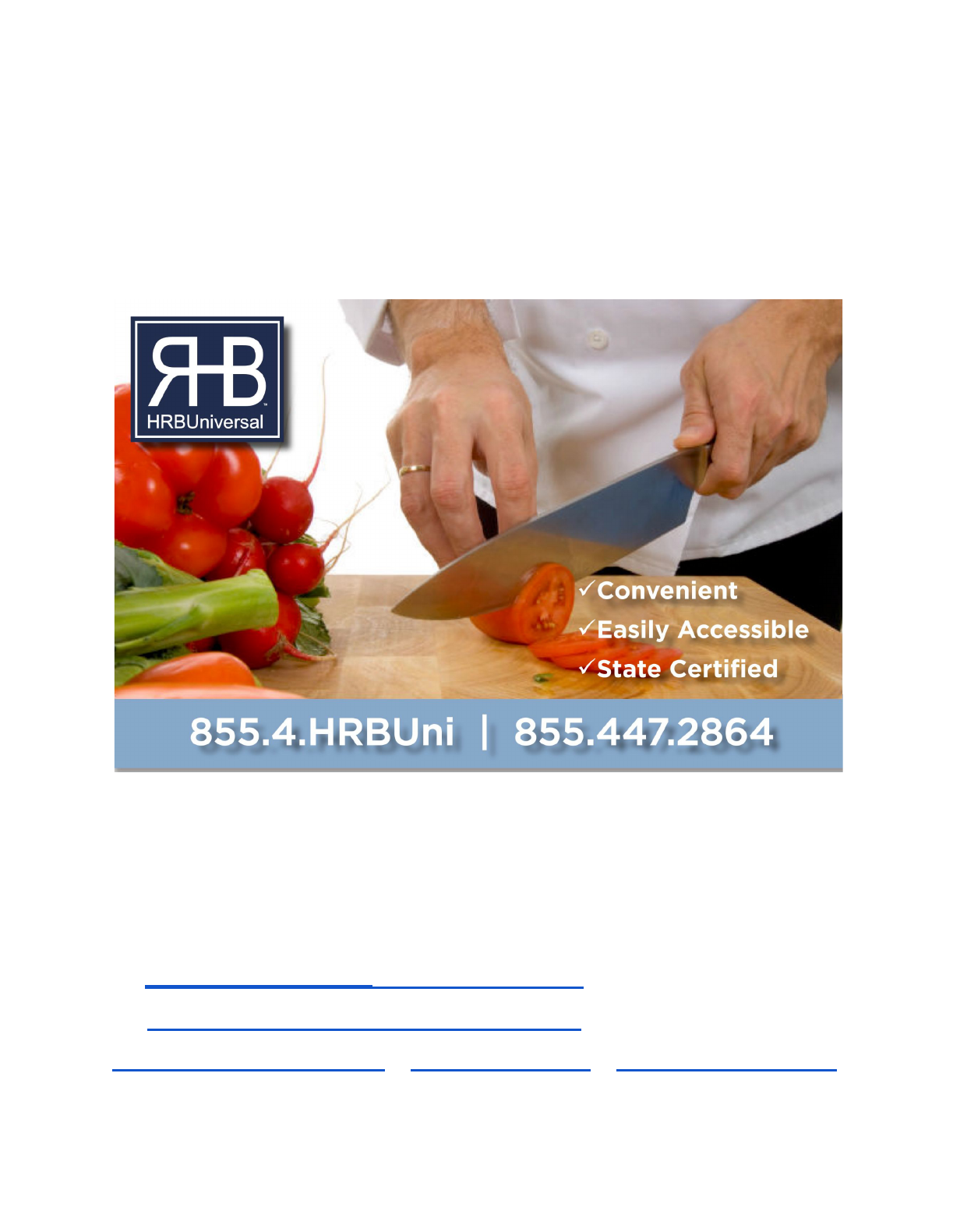
ServSafe® Certified Food Portection Manager Exam Version
Certified Professional Food
Manager Certification Study Guide
Update October 5, 2023
HRBUniversal, LLC
855.4.HRBUni (855.447.2864) | Talk, Text, Fax
866.WeGoHRB (866.934.6472) | Talk, Text, Fax
[email protected] | HRBUni.com | WeGoHRB.com
No portion of this document can be duplicated or transmitted in any form without prior written
permission of HRBUniversal, LLC. and violates HRBUniversal, LLC copyright permissions.
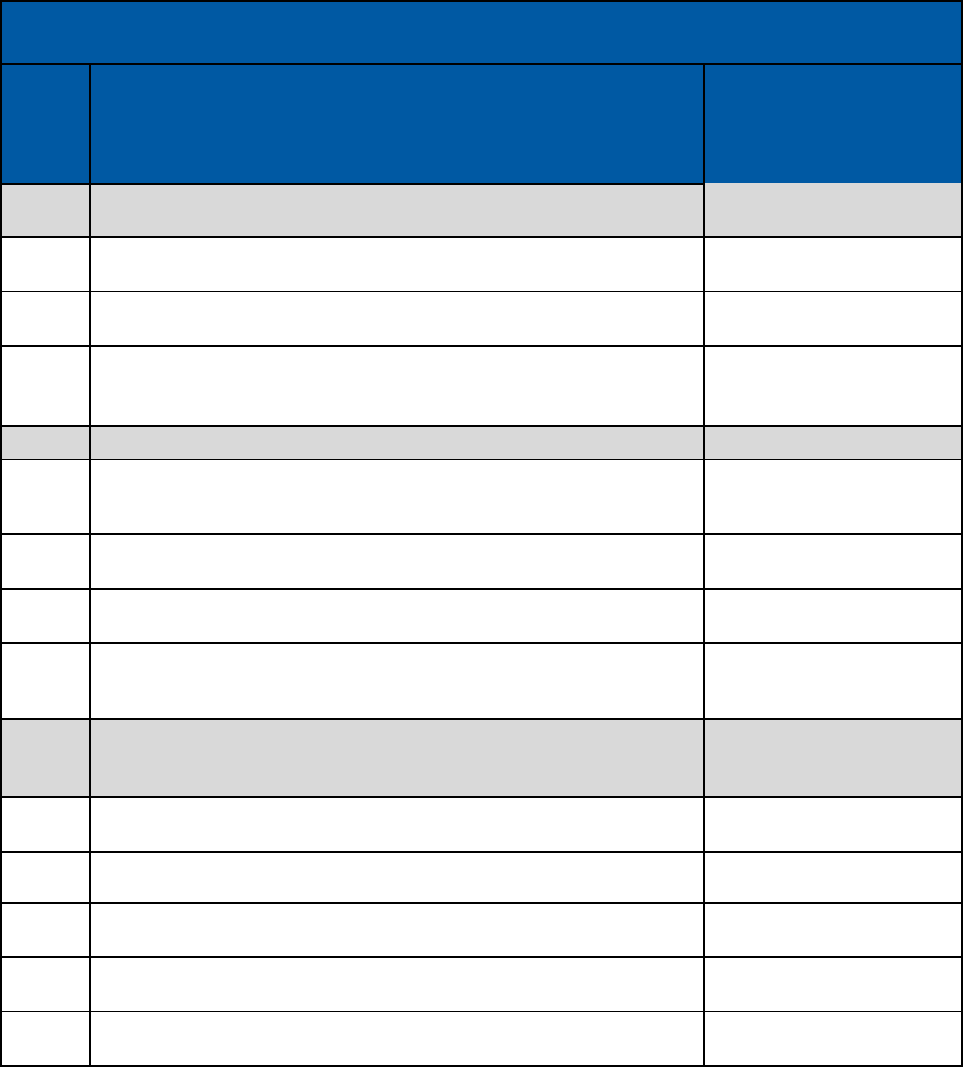
ServSafe Manager Course & Exam - Domains, Tasks, References
Domain
Job Task Name
Section
1
Management of Food Safety Practices - 9 Questions
!!
Task: Practice Active Managerial Control; comply with regulatory
requirements
Food Safety Management
Systems
!!
Task: Respond to emergencies and follow procedures with regulatory
agencies
Safe Facilities & Pest
Management
!!
Task: Determine if there is a significant risk of deliberate contamination
of food and respond appropriately
Forms of Contamination
2
Hygiene and Health - 14 Questions
!!
Task: Ensure proper handwashing procedures are followed
The Safe Food Handler
!!
Task: Monitor employee personal hygiene and cleanliness
The Safe Food Handler
Task: Enforce employee illness requirements based on reported and/or
observed symptoms
The Safe Food Handler
Prevent contamination of food by employees
The Safe Food Handler
3
Safe Receipt, Storage, Transportation, and Disposal of Food - 13
Questions
!!
Task: Ensure proper receiving procedures for food and non-food items
Purchasing, Receiving and
Storage
!!
Task: Store food and non-food items properly
Purchasing, Receiving and
Storage
Task: Follow distressed merchandise and product recall procedures
Purchasing, Receiving and
Storage
!!
Task: Dispose of food that does not meet food safety requirements
Purchasing, Receiving and
Storage
Task: Ensure procedures for off-site catering, food transportation, and
delivery are followed
Service
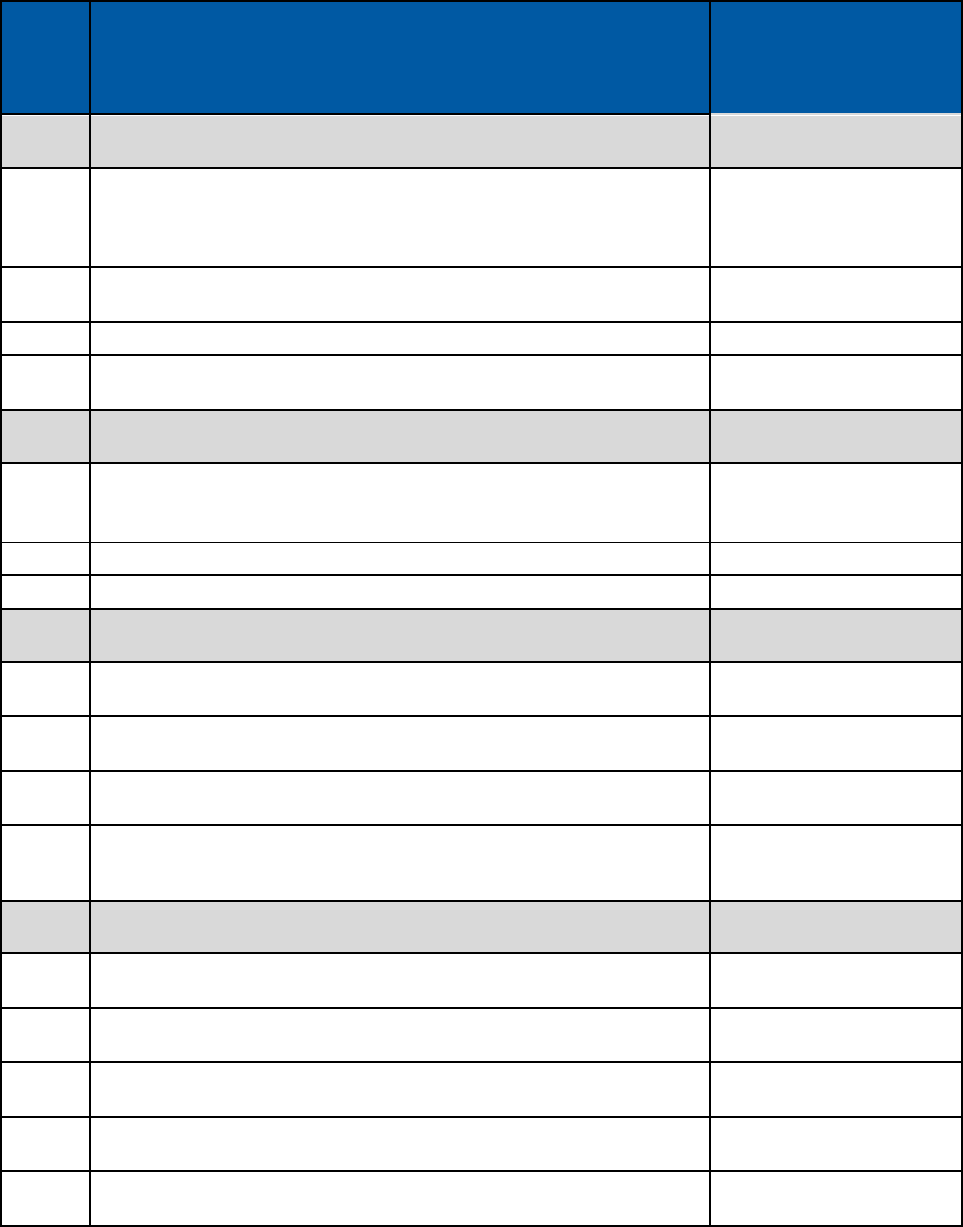
Domain
Job Task Name
Section
4
Safe Preparation and Cooking of Food - 15 Questions
!!
Task: Ensure that proper time and temperature procedures are
maintained during preparation and cooking
Preparation
Job Task
Job Task
Name
Percent
of Exam
Scored
Items per
Form*
ServSafe
Manager
Chapter
!!
Task: Identify and minimize risks for facilities serving highly susceptible
populations
Preparation
!!
Task: Minimize the different types of contaminants
Forms of Contamination
Task: Minimize the different types of major food allergens
Forms of Contamination
5
Safe Service and Display of Food - 8 Questions
!!
Task: Ensure proper time and temperature procedures are maintained
during display and service of food
Service
!!
Task: Ensure proper use of barrier with RTE foods
Service
Task: Comply with consumer advisory requirements
Preparation
6
Cleanliness and Sanitation - 11 Questions
Task: Use and store approved cleaning agents, chemicals, and tools
properly
Cleaning and Sanitizing
!!
Task: Ensure all non-food contact surfaces are cleaned
Cleaning and Sanitizing
Task: Ensure all food contact surfaces are cleaned and sanitized
Cleaning and Sanitizing
Task: Dispose of waste and biohazard material properly
Cleaning and Sanitizing
Safe Facilities and Pest
Control
7
Facilities and Equipment - 10 Questions
Task: Ensure proper operation of facilities and equipment
Safe Facilities and Pest
Control
Task: Follow Master Cleaning Schedule and adjust as necessary
Cleaning and Sanitizing
Task: Ensure sinks are properly maintained and accessible for intended
uses
Safe Facilities and Pest
Control
Task: Reduce pest risks through facility maintenance and working with
PCO as appropriate
Safe Facilities and Pest
Control
Task: Ensure the equipment meets approved standards for foodservice
equipment
Safe Facilities and Pest
Control

INTRODUCTION
No matter which ANSI-CFP Certified Food Protection Manager Exam you choose this guide will help you
will help you prepare for the exam.
The Certified Professional Food Manager Study Guide Study Guide is based on the 2022 FDA (Food and
Drug Administration). Your state may not have adopted the current code yet so after the course/exam
please review your local, county, or state food code to make sure you are following all guidelines. This
guide does not replace any food safety national publications (ServSafe® ® Food Manager, ServSafe®
Course Books, NEHA®, SURE® and SafeMark®).
At no time do HRBUniversal, Instructors, Staff, and Websites provide regulatory or legal advice in regard to
any food code or food law. Please contact the local, county, or state health department on all matters
pertaining to food safety in your operation in your area and consult your legal counsel.
Topics covered are:
● Providing Safe Food
● Forms of Contamination
● The Safe Food Handler
● The Flow of Food: Receiving & Storage, Preparation and Service
● Food Safety Management Systems and HACCP
● Sanitary Facilities & Design
● Pest Management
ANSI-CFP Accreditation Program (Accredited Exams)
1. 1 AAA Food Safety (AAA Food Safety, LLC)
2. APS Culinary Dynamics (DBA: World Food Safety Organization)
3. Certus/StateFoodSafety
4. Learn2Serve
5. My Food Service License
6. National Registry of Food Safety Professionals (NRFSP)
7. National Restaurant Association Solutions (ServSafe)
8. Relish Works, Inc. (DBA: Trust20)
9. Responsible Training / Safeway Certifications, LLC
10. The Always Food Safe Company, LLC
Prior to the course or exam session please take time to look over the study guide and take the practice test
& quizzes. The practice test will help you understand how they ask the questions on the ANSI-CFP
Certified Food Protection Manager Exam. Read your questions. Read them out loud to yourself. One
word can change the complete meaning of the question. You always want the most correct answer.
2022 FDA Food Code Updates are highlighted in yellow. Please pay attention to these changes.

PROVIDING SAFE FOOD
FOODBORNE ILLNESS is a disease carried or transmitted to people by food.
A FOODBORNE ILLNESS OUTBREAK is when two or more people experience the same illness after
eating the same food.
HIGHER RISK POPULATIONS INCLUDE Infants, preschool-age children, the elderly, people taking
medications, and people who are seriously ill.
Although any type of food can become contaminated, some can better support the rapid growth of
microorganisms than others.
These foods require TEMPERATURE CONTROL FOR SAFETY (TCS).
TCS Foods must be kept out of the Danger Zone (41° - 135°) to prevent the growth of microorganisms
and the production of toxins.
TCS FOODS include Milk, Eggs, Shellfish, Fish, Meats, Meat Alternatives, Untreated Garlic and Oil
Mixtures, Baked Potatoes, Raw Sprouts, Cooked Rice, Cut Tomatoes, Cut Melons and prepped foods.
THREE TYPES OF CONTAMINATIONS (Hazards)
● BIOLOGICAL – Bacteria, Viruses, Parasites, Fungi, Natural Toxins
● CHEMICAL – Cleaners, Sanitizers, Toxic Metal from Non-Food Service Grade Utensils and
Cookware, Pesticides
● PHYSICAL – Foreign Objects – Hair, Glass, Paper, Metal Shavings
THE CENTER FOR DISEASE CONTROL (CDC) TOP FIVE DOCUMENTED REASONS FOR
OUTBREAKS:
1. Purchasing food from unsafe sources
2. Failing to cook food adequately
3. Holding food at incorrect temperatures
4. Contaminated equipment
5. Poor personal hygiene
FOUR WAYS FOOD BECOMES CONTAMINATED
1. Time-Temperature Control -TCS foods are left in the danger zone for > 4 hours
2. Cross Contamination Contaminants cross to a food that is not going to be cooked any further
3. Poor Personal Hygiene Food handlers cause foodborne illness
4. Poor Cleaning & Sanitizing
READY-TO-EAT FOODS ARE ITEMS THAT CAN BE CONSUMED WITHOUT FURTHER
● Ready-to-eat food includes cooked food, plant foods cooked for hot-holding, washed fruit and
vegetables (whole and cut), and deli meat. Bakery items and sugar, spices, and seasonings are
other examples of ready-to-eat food.

KEEPING FOOD SAFE & TRAINING
Focus on these measures
● Controlling time and temperature
○ The Food and Drug Administration (FDA) recommends that regulatory authorities hold the
person in charge of a food service operation responsible for ensuring the following standards
are met:
■ Food handlers are regularly monitoring food temperatures during hot and cold holding.
● Preventing cross-contamination
● Practicing personal hygiene
● Purchasing from approved, reputable suppliers
● Cleaning and sanitizing
Training and Monitoring
● Train staff to follow food safety procedures
● Provide initial and ongoing training
● Provide all staff with general food
safety knowledge
● Provide job-specific food safety training
● Retrain staff regularly
● Monitor staff to make sure they are following procedures
● Document training
CERTIFIED FOOD PROTECTION MANAGER
The 2017 Food Code included a requirement that the person in charge of a restaurant or foodservice
operation become a Certified Food Protection Manager.
The Supplement to the 2017 FDA Food Code provided an exception to the requirement that the
certified food protection manager be onsite at all times.
The Importance of Becoming a Certified Food Protection Manager
The FDA Food Code requires that the person in charge of a food service operation become a
Certified Food Protection Manager. That person must be onsite at all times during all
operating hours unless the regulatory authority has determined that the operation poses a
minimal risk of causing a foodborne illness. That decision would be based on the operation
type and the type of food that is served or sold. Cashierless markets and convenience stores
are good examples of operations where the person in charge may not be required to be
onsite at all times.
A Certified Food Protection Manager must show that they have the required knowledge by
passing a test from a program that is accredited by an agency approved by a Conference for
Food Protection. Completing the ServSafe Manager Course and passing the ServSafe Food
Protection Manager Certification Examination meets this requirement. But why is certification
important?
A Centers for Disease Control and Prevention study suggests that the presence of a Certified
Food Protection Manager reduces an establishment’s risk of a foodborne illness outbreak.
The study also suggests that it was a distinguishing factor between restaurants that

experienced a foodborne illness outbreak and those that had not. In addition, the FDA’s Retail
Food Risk Factor Studies suggest that the presence of a certified manager has a positive
correlation with more effective control of certain risk factors, such as poor personal hygiene,
in different facility types.
GOVERNMENT AGENCIES
● The Food and Drug Administration (FDA) inspects all food except meat, poultry, and eggs. The
agency also regulates food transported across state lines. In addition, the agency issues the FDA
Food Code , which provides recommendations for food safety regulations.
● The U.S. Department of Agriculture (USDA) regulates and inspects meat, poultry, and eggs. It
also regulates food that crosses state boundaries or involves more than one state.
● Agencies such as the Centers for Disease Control and Prevention (CDC) and the U.S. Public
Health Service (PHS) conduct research into the causes of foodborne illness outbreaks.
● State and local regulatory authorities write or adopt code that regulates retail and food service
operations.

FORMS OF CONAMINATION
HOW CONTAMINATION HAPPENS
● Contamination comes from a variety of places.
● Contaminants can cause foodborne illness or result in physical injury.
● Contaminants are found in the animals we use for food, the air, water, and dirt, and occur naturally
in food, such as bones in fish.
● Food can be contaminated on purpose.
● Most food is contaminated accidentally.
● Examples of accidental contamination include: food handlers who don’t wash their hands after using
the restroom, and then contaminate food and surfaces with feces from their finger; and food
handlers who pass contaminants through illness
FOODBORNE INFECTIONS can result when a person eats food-containing pathogens, which
then grow in the intestines and cause illness.
Common Symptoms of Foodborne Illness
● Diarrhea
● Vomiting
● Fever
● Nausea
● Abdominal cramps
● Jaundice (yellowing of skin and eyes)
Onset times
● Depend upon the type of foodborne illness
● Can range from 30 minutes to 6 weeks
FOODBORNE INTOXICATIONS result when a person eats food-containing toxins (poison) produced by
pathogens found on the food or which are results of chemical contamination. Typically symptoms appear
quickly, within a few hours.
BACTERIA are of the greatest concern of the biological contaminates. Bacteria are found everywhere and
under favorable conditions, they can reproduce very rapidly if FAT TOM conditions are right.
The acronym FAT TOM stands for:
● F ood - Most bacteria need nutrients to survive. TCS food supports the growth of bacteria better than
other types of food.
● A cidity - Bacteria grow best in food that contains little or no acid on a pH Scale that ranges from 0
to 14.0 acid to alkaline. Bacteria grew right in the middle more rapidly - 4.6pH - 7.5pH.
● T emperature - Bacteria grow rapidly between 41˚F and 135˚F (5˚C and 57˚C). This range is known
as the temperature danger zone. Bacteria growth is limited when food is held above or below the
temperature danger zone.
● T ime - Bacteria need time to grow. The more time bacteria spend in the temperature danger zone,
the greater chance they have to grow to unsafe levels. Bacteria doubles every 20 minutes in the
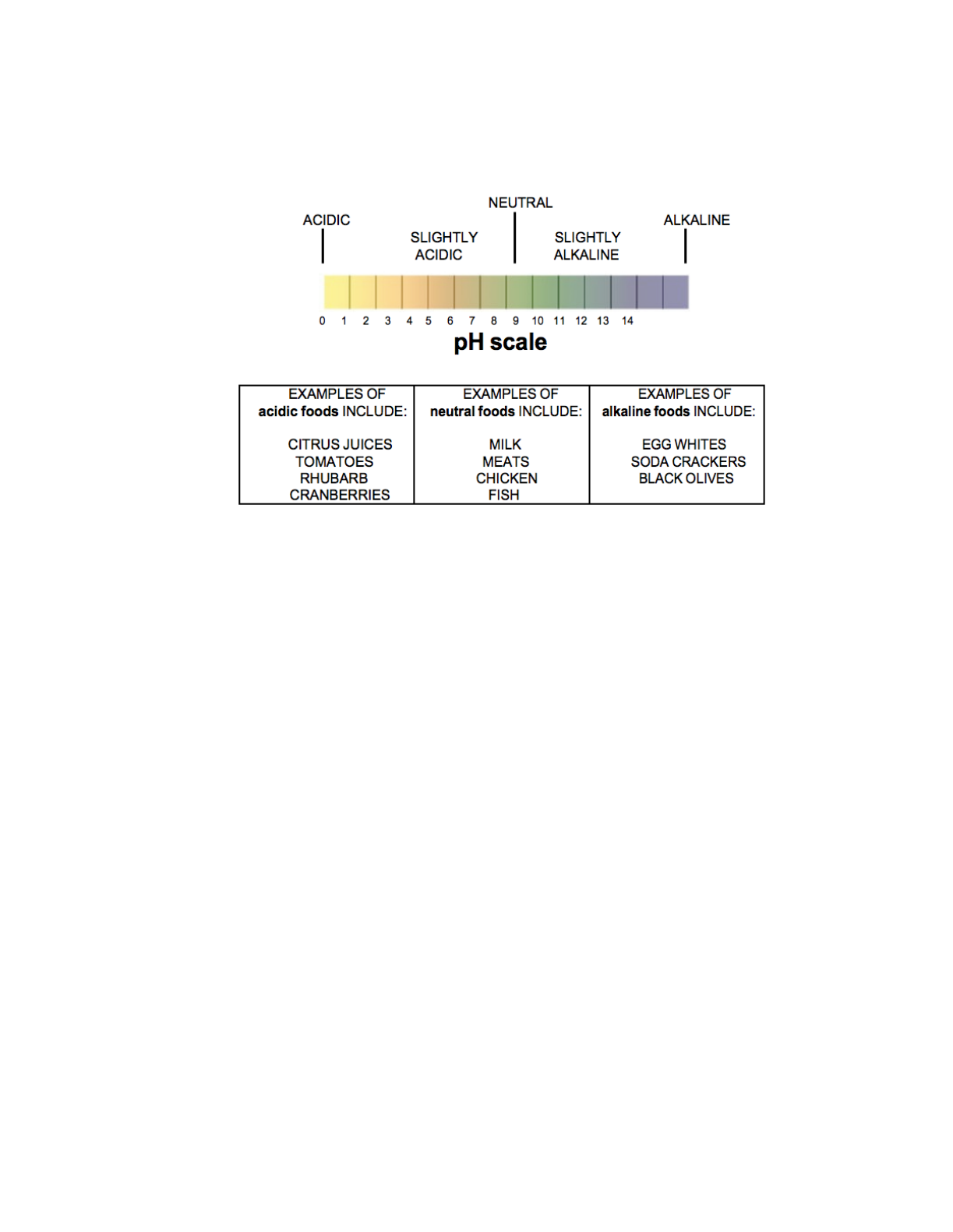
TDZ.
● O xygen - Some bacteria need oxygen to grow, while others grow when oxygen isn’t there (ROP).
● M oisture - The amount of moisture available in food is called water activity (aw). The aw scale
ranges from 0.0 to 1.0. The higher the value, the more available moisture in the food.
Time and Temperature are the easiest things for us to control.
MAJOR BACTERIA THAT CAUSES FOODBORNE ILLNESS
The FDA has identified three types of bacteria that cause severe illness and are highly contagious.
● Salmonella Typhi
○ Salmonella Typhi lives only in humans.
○ People with typhoid fever carry the bacteria in their bloodstream and intestinal tract.
○ Eating only a small amount of these bacteria can make a person sick.
○ The severity of symptoms depends on the health of the person and the amount of bacteria
eaten. The bacteria are often in a person’s feces for weeks after symptoms have ended.
● Nontyphoidal Salmonella
○ Many farm animals carry me naturally.
○ The severity of a person’s symptoms depends on how much of me is eaten.
○ I’ve been found in tomatoes, peppers, and cantaloupes.
○ Cooking poultry or eggs to the right temperature can prevent me from causing illness.
● Shigella spp.
○ Shigella spp. is found in the feces of humans with the illness.
○ Most illnesses occur when people eat or drink contaminated food or water.
○ Flies can also transfer the bacteria from feces to food.
○ Eating only a small amount of these bacteria can make a person sick.
○ High levels of the bacteria are often in a person’s feces for weeks after symptoms have
ended.
● Enterohemorrhagic and Shiga toxin-producing Escherichia coli (E. coli)
○ Enterohemorrhagic and Shiga toxin-producing E. coli can be found in the intestines of cattle.
○ It is also found in infected people.

○ The bacteria can contaminate meat during slaughtering.
○ Eating only a small amount of the bacteria can make a person sick.
○ Once eaten, it produces toxins in the intestines, which cause the illness.
○ The bacteria are often in a person’s feces for weeks after symptoms have ended.
VIRUSES are the smallest of the microbial contaminants. While a virus cannot reproduce in the food, once
consumed it will cause illness. Viruses are spread from PERSON TO PERSON, PERSON TO FOOD, AND
PERSON TO FOOD CONTACT SURFACES. Practicing good personal hygiene and minimizing
bare-hand contact with ready-to-eat food can help defend against viral foodborne illnesses.
Location
● Carried by human beings and animals.
○ Require a living host to grow
○ Do not grow in food
○ Can be transferred through food and remain infectious in food
Sources
● Food, water, or any contaminated surface.
● Typically occur through fecal-oral routes.
Destruction
● Some viruses, such as hepatitis A, are not destroyed by normal cooking temperatures. That
is why it is especially important to practice good personal hygiene when handling food and
food-contact surfaces. The quick removal and cleanup of vomit is also important.
● Not destroyed by normal cooking temperatures.
● Good personal hygiene must be practiced when handling food and food-contact surfaces.
● Quick removal and cleanup of vomit is important
The FDA has identified 2 viruses that are highly contagious and can cause severe illness.
● Hepatitis A
○ Hepatitis A is mainly found in the feces of people infected with it.
○ The virus can contaminate water and many types of food.
○ It is commonly linked with ready-to-eat food. However, it has also been linked with shellfish
from contaminated water.
○ The virus is often transferred to food when infected food handlers touch food or equipment
with fingers that have feces on them.
○ Eating only a small amount of the virus can make a person sick.
○ An infected person may not show symptoms for weeks but can be very infectious.
○ Cooking does not destroy Hepatitis A.
● Norovirus
○ Like Hepatitis A, Norovirus is commonly linked with ready-to-eat food.
○ It has also been linked with contaminated water.
○ Norovirus is often transferred to food when infected food handlers touch food or equipment
with fingers that have feces on them.
○ Eating only a small amount of Norovirus can make a person sick. It is also very contagious.
○ People become contagious within a few hours after eating it.
○ The virus is often in a person’s feces for days after symptoms have ended.
Food handlers diagnosed with an illness from Hepatitis A or Norovirus must not work in an operation while

they are sick.
Cleaning up Vomit and Diarrhea in the Operation
The 2017 FDA Food Code added a requirement to have written procedures for cleaning up vomit and
diarrhea in the operation. ServSafe addresses this as follows:
● Cleaning up after People Who Get Sick
○ To be effective, operations must have written procedures for cleaning up vomit and diarrhea.
These procedures must address specific actions that employees must take to minimize
contamination and exposure to food, surfaces, and people. It is critical that employees be
trained on these procedures.
○ Must have a body fluid clean-up kit and chemicals on site and accessible.
PARASITES are organisms that need a living host to survive. Proper cooking and freezing kill parasites.
● Location
○ Require a host to live and reproduce
● Source
○ Seafood, wild game, and food processed with contaminated water, such as produce
● Prevention
○ Purchase food from approved, reputable suppliers
○ Cook food to required minimum internal temperatures
○ Fish that will be served raw or undercooked, must be frozen correctly by the manufacturer
FUNGI , such as molds and yeast are generally responsible for spoiling food and rarely cause illness. They
can grow in almost any condition but grow well in acidic foods. Some molds, however, can produce harmful
toxins. Yeasts can spoil food rapidly and will produce a smell or taste of alcohol. Foods spoiled by yeast
should also be discarded.
Yeasts, molds, and mushrooms
● Some molds and mushrooms produce toxins
● Throw out moldy food, unless mold is a natural part of the food
● Purchase mushrooms from approved, reputable suppliers
BIOLOGICAL TOXINS
Origin
● Naturally occur in certain plants, mushrooms, and seafood
Seafood Toxins
● SCOMBROID – Histamine Toxin – Tuna, Mackerel, Bonito, Mahi Mahi are time-temperature abused.
● CIGUATERA - Ciguatoxin, predatory reef fish (Barracuda, Grouper, Jacks, and Snapper) - marine
algae.
Purchase fish from APPROVED SUPPLIERS since cooking or freezing cannot destroy these toxins.
Produce – All produce should be purchased from an approved supplier. This will prevent illnesses

associated with wild mushrooms and produce that has been contaminated with sewage or chemicals.
CHEMICAL CONTAMINANTS can come from a wide variety of substances including toxic metals,
pesticides, cleaning products, sanitizers, lubricants, first aid, and personal care products. To prevent
contamination, such as lead in a pewter pitcher, use only approved food-grade utensils & equipment to
prepare and store food. If carbonated beverage dispensers are installed improperly, and carbonated water
is allowed to flow back into the copper supply lines, it could leach copper from the line and contaminate the
beverage. Only allow a licensed professional to apply pesticides.
Symptoms
● May vary depending on the chemical consumed
● Most illnesses occur within minutes
● Vomiting and diarrhea are typical
Prevention
● Only use chemicals approved for use in food service operations.
● Purchase chemicals from approved reputable suppliers.
● Store chemicals away from prep areas, food-storage areas, and service areas.
○ Chemicals must be separated from food and food-contact surfaces by spacing and
partitioning.
● Chemicals must never be stored above food or food-contact surfaces.
● Use chemicals for their intended use and follow the manufacturer’s directions.
● Only handle food with equipment and utensils approved for food service use.
● Make sure the manufacturer’s labels on original chemical containers are readable
● Keep SDS current and make sure they are accessible to staff at all times.
● Follow the manufacturer’s directions and
local regulatory requirements when throwing out chemicals.
PHYSICAL CONTAMINATION can occur when foreign objects are accidentally introduced into food.
Common physical contaminants include metal shavings from cans, staples, glass from broken light bulbs,
fingernails, hair, Band-Aids, dirt, etc.
Symptoms
● Mild to fatal injuries are possible
● Cuts, dental damage, and choking
● Bleeding and pain
Prevention
● Purchase food from approved, reputable suppliers
● Closely inspect food received
● Take steps to prevent physical contamination, including practicing good personal hygiene
FOOD SECURITY & CRISIS MANAGEMENT addresses the prevention or elimination of the deliberate
contamination of food. The key to protecting food is to make it as difficult as possible for tampering to occur
by addressing all potential HUMAN, INTERIOR, and EXTERIOR elements in your operation
To build a crisis-management team program:
● Create a crisis-management team
● Prepare for different types of crisis
● Tailored to your operation
● Test your plan and make sure it addresses – Preparation, Response, and Recovery.

Use the FDA Defense Tool
A.L.E.R.T.
● A ssure Make sure products received are from safe sources
● L ook Monitor the security of products in the facility
● E mployees Know who is in your facility
● R eports Keep information related to food defense accessible
● T hreat Develop a plan for responding to suspicious activity or a threat to the operation
Responding to a Foodborne-Illness Outbreak
● Train staff on food safety policies and procedures
● Create an emergency-contact list
● Gather information
● Notify authorities
● Segregate product
● Document all information with a foodborne-illness incident report form and train staff to use it.
● Identify staff
● Cooperate with authorities
● Review procedures
Imminent Health Hazards - Water or Electrical Interruptions
● The 2017 FDA Food Code added requirements for allowing an operation to continue operating
during a water or electrical interruption.
● The regulatory authority may allow an operation to continue operating in the event of a water or
electrical interruption under the following conditions:
○ The operation has a written emergency operating plan approved in advance by the regulatory
authority.
○ An immediate corrective action is taken to prevent, eliminate, or control any food safety risk
and imminent health hazard associated with the interruption.
○ The regulatory authority is informed upon implementing the emergency operating plan.
FOOD ALLERGIES
An allergic reaction could include itching, tightening of the throat, wheezing, hives, swelling, diarrhea,
vomiting, cramps, loss of consciousness, or even death. Managers and employees should be aware of the
most common.
Required Employee Training in Food Allergy Awareness
The 2022 FDA Food Code clarifies that proper employee training in food allergy awareness must include
the ability to identify the major food allergens as well as the symptoms of an allergic reaction.
Food Allergens
It’s important to be aware that there are many risks to manage in an operation in addition to biological,
chemical, and physical contaminants. Other issues, such as allergic reactions from food allergens, are a
real and growing concern. Some individuals with food allergies may need to eat a quantity of the food to
experience a reaction. Some others may be affected by only a slight exposure to the allergen. Managers

need to have policies and procedures in place to accommodate guests who have food allergies. Staff
needs to know how to handle these situations as well. But many people don’t know what food allergens are
and how to deal with them. When interacting with guests who have a food allergy, we all need to remember
that it is not as simple as just a dietary choice. It is a medical condition.
A food allergen is a protein in a food or ingredient. When enough of an allergen is eaten, it can cause an
allergic reaction in some people. This happens because their immune system mistakenly considers the
food protein, which is normally harmless, to be a threat and attacks it.
There are specific signs that a customer is having an allergic reaction. To protect your customers, you and
your staff should be able to recognize these signs and know how to respond. You also should know the
types of food that most often cause allergic reactions to help prevent them from happening.
Common Food Allergens
You and your staff must be aware of the most common food allergens and the menu items that contain
them. While nearly any food can cause an allergic reaction, there are nine foods that are responsible for
most in the United States. They are called the Big Nine.
● The 2022 FDA Food Code added sesame as the ninth major food allergen. This changes the major
food allergens from the “Big Eight” to the “Big Nine.”
○ Milk
○ Eggs
○ Fish, such as tuna and cod
○ Shellfish, including lobster, shrimp, and crab
○ Wheat
○ Soybeans (soy)
○ Peanuts
○ Tree nuts, such as almonds, walnuts, and pecans, pine nuts
○ Sesame
Food Allergy Symptoms
A food allergy is the reaction a person’s immune system has to a certain food. An allergic reaction can
happen within a few minutes or up to two hours afterward and could include some or all of these
symptoms:
● Wheezing
● Difficulty breathing
● Hives
● Rashes
● Itching
● Tingling in the mouth
● Swelling, including the tongue and throat
● Abdominal cramps
● Diarrhea
● A drop in blood pressure
● Loss of consciousness
Reactions can vary widely. In some cases, a person could suffer anaphylaxis—a severe life-threatening
allergic reaction that can lead to death.

If you or your staff see a customer having severe symptoms, or the customer tells you they are having a
severe allergic reaction, act immediately. Let other staff know that assistance is needed and instruct them
to call emergency medical services. Do not leave the person alone.
Preventing Allergic Reactions
Tens of millions of Americans have food allergies. Allergic reactions result in tens of thousands of
emergency room visits every year—about once every three minutes. Both front-of-house and
back-of-house staff need to do their part to avoid serving food containing allergens to people with food
allergies. These precautions also apply to any food sensitivities that a customer might mention, such as a
gluten intolerance.
Food Labels
Food labels are an important tool used to identify allergens in the products that you purchase. Federal law
requires that major allergens be clearly identified on labels on packaged foods. The allergen must be found
within the ingredient listing or directly after the listing on the label. The information must use the Big Nine
allergen common names. As an alternative, the allergens can be listed in one spot using a “contains” label.
Front-of-House Staff
Your front-of-house staff is critical when it comes to preventing allergic reactions. They have the first
opportunity to find out about your guests’ food allergies. This information must be communicated to staff in
the back of the house to prevent allergic reactions.
Here’s what your front-of-house staff must do to prevent an allergic reaction. ( Note: The content in this
section has changed substantially.)
● Inform guests about allergens on menus. The way that you communicate this is going to depend
on your menu and service style. Some operations note allergens in the menu or include disclaimers
requesting that guests inform their server of any food allergies. Staff can inform guests of food
allergens by:
○ Bringing food labels to guests
○ Reading ingredient labels to guests when asked
○ Telling guests about menu items
● Listening to guests. Answer all guests’ questions about menu items. Some guests may not inform
you that they have a food allergy. When a guest asks about substituting ingredients or mentions
being sensitive to something, it’s important to check if they have a food allergy.
The first person that a guest speaks with, the “first point of contact,” should have some knowledge of
food allergies. Once you know that a guest has a food allergy, pay attention, take notes, and read
the notes back to them to make sure they are correct.
● Communicate the allergen special order to back-of-house staff. Provide kitchen staff with
written notes about the guest’s allergen special order. Verbally confirm the order with the kitchen
staff when it is placed. When collecting the order from the kitchen, confirm the meal is correct and
matches the ticket. Always confirm the allergen special order verbally with the kitchen staff.
● Deliver the allergen special order safely. Always confirm the order verbally with the guest. To
prevent cross-contact, some operations deliver the allergen special order first, separate from other
items. As an alternative, all orders for the table can be delivered at the same time with an additional
server or manager delivering just the special meal.
● Avoid cross-contact in workstations. Keep workstations clean. Don’t mix old products with new

products. Be careful when restocking stations. Avoid spills and clean carefully if they do happen.
Use new, clean tools (i.e., ladles, serving baskets, etc.) when handling orders. Prepare things like
breadbaskets and salads at a separate location used just for allergen special orders, if possible.
● Clean and sanitize. Replace soiled cloths and cleaning and sanitizing solutions regularly. Clear and
clean tables and chairs for guests with food allergies. When resetting tables, be mindful of
condiments or other food items that may contain allergens. Clean spills immediately and common
surfaces regularly.
Back of House Staff
● How to Avoid Cross-Contact
○ Here’s how to prevent cross-contact in the back of the house and keep customers safe.
■ Review the menu and ingredients for Big Nine allergens. Check recipes and
ingredient labels. Any ingredient substitutions should be identified, tested in advance,
and noted in recipes. Managers, chefs, and purchasers should stay in regular
communication with vendors. If there are any questions about uncertain or new
ingredients, check with the vendor.
■ Receive and store items correctly. Check deliveries carefully. If substitute items
have been provided, check the ingredient labels. Also, check to see if any packaging
has been broken or spilled. Reject deliveries if inappropriate substitute items have
been provided or anytime cross-contact is suspected.
● Items intended for allergen special orders should be properly labeled and stored
separately from Big Nine allergens.
○ Clean surfaces, utensils, and equipment. Wash, rinse, sanitize, and air-dry surfaces and
equipment to remove allergens. Use fresh cleaning solutions and cleaning cloths when
cleaning items to be used for an allergen special order.
○ Use separate utensils and equipment for allergen special orders. All designated
equipment should be properly identified and stored separately.
○ Practice good personal hygiene. Wash hands and change gloves before preparing an
order for a guest with a known food allergy. Avoid touching anything that may have had
contact with a food allergen, including uniforms, skin, and hair.
○ Prepare the allergen special order correctly. When the order is received, check the ticket
and verbally confirm the order with the server. Check written recipes and ingredient labels to
confirm that the allergens in question are not present. Follow recipes and only use approved
ingredient substitutions. Discard the item if cross-contact has occurred. Do not add anything
to an item that has been plated or packaged. Verbally confirm the order with the person who
will be serving it to the guest. Do not serve items that cannot be prepared safely.

THE SAFE FOOD HANDLER
FOOD HANDLERS have the potential to contaminate food when they have been diagnosed with a
foodborne illness, show symptoms of a gastrointestinal, have infected lesions, or touch anything that could
contaminate their hands.
Managers must focus on the following:
● Creating personal hygiene policies
● Training food handlers on personal hygiene policies and retraining them regularly
● Modeling correct behavior at all times
● Supervising food safety practices
● Revising personal hygiene policies when laws or science change
PROPER HAND WASHING must always be practiced, because simple acts like nose picking, or touching
one's hair can contaminate food. This is especially important before starting work, after using the restroom,
after sneezing, coughing, smoking, eating, drinking , handling raw food, & handling garbage.
Washing Hands after Using Tobacco Products
The 2022 Food Code has expanded the requirement from washing hands after “smoking” and “chewing
tobacco” to washing them after “using tobacco products” to address and include vaping and similar
activities.
Eating, drinking, chewing gum, or using tobacco products (including chewing tobacco, cigarettes, and
devices that deliver nicotine electronically, such as e-cigarettes, vapes, and mods).
● Prohibition against Using “Tobacco Products” in the Establishment
○ Smoking and chewing tobacco is prohibited in an establishment except in designated areas.
The 2022 Food Code has expanded the prohibition from “smoking” and “chewing tobacco” in
an establishment to the broader “use of tobacco products” to address and include vaping and
similar activities.
● Eating, Drinking, Chewing Gum, and Using Tobacco Products
○ Small droplets of saliva can contain thousands of pathogens. In the process of eating,
drinking, chewing gum, or using tobacco products (including chewing tobacco, cigarettes, and
devices that deliver nicotine electronically, such as e-cigarettes, vapes, and mods), saliva can
be transferred to hands or directly to food being handled.
○ To prevent this, employees should only eat, drink, chew gum, or use tobacco products in
designated areas.
STEPS IN HANDWASHING
1. Turn on warm water – (85°F minimum – Confirm with state/local food code)
2. Apply soap
3. Scrub hands & arms for 10-15 SECONDS.
4. Rinse
5. Dry with a single-use towel or air dry
Total time of the process is 20 SECONDS.
HAND ANTISEPTICS
● Liquids or gels used to lower the number of pathogens on skin
● Must comply with the CFR and FDA standards
● Should be used only after hand washing
● Must never be used in place of hand washing
● Should be allowed to dry before touching food or equipment

HANDS
● Fingernails short & clean nails, cuts & wounds covered with clean bandages and gloves. If finger
cots are used a single-use glove must be used to cover. This is for the front & back of the house
staff.
● Covering Wounds
○ The 2017 FDA Food Code further clarified the requirement for covering a wound or boil on
the hand, finger, or wrist. ServSafe addresses this as follows:
○ Infected wounds or boils
■ If the wound or boil is located on the hand, finger, or wrist:
● Cover it with an impermeable cover like a finger cot or bandage. Impermeable
means that liquid from the wound cannot pass through the cover.
● Then, place a single-use glove over the cover.
GLOVES & FINGER COTS
● Gloves should never be used in place of hand washing. Hands must be washed before putting on
gloves if tasks are changed. Gloves used to handle food are for single use and should never be
washed or reused. They must be changed at least every FOUR HOURS , when they become soiled
or torn, or when beginning a new task.
● All infected areas of skin must be covered with an impermeable cover. If hands a single-use glove
must be used. If on body parts they must be covered properly with pants, shirt sleeves, and
effective hair restraints.
○ Covering Wounds
■ The 2017 FDA Food Code further clarified the requirement for covering a wound or
boil on the hand, finger, or wrist. ServSafe addresses this as follows:
■ Infected wounds or boils
● If the wound or boil is located on the hand, finger, or wrist:
○ Cover it with an impermeable cover like a finger cot or bandage.
Impermeable means that liquid from the wound cannot pass through the
cover.
○ Then, place a single-use glove over the cover.
PERSONAL HYGIENE
● Can be a sensitive subject for some people, but it must be addressed with every employee because
it is vital to food safety. All employees must bathe or shower before work and keep their hair clean.
Prior to handling food, employees must put on clean clothing, appropriate shoes, and a clean hair
restraint or hat.
JEWELRY & APRONS
● They must also remove jewelry from their hands and arms. Only a plain band should be allowed.
This includes medical ID bracelets (Which can be worn around the neck or ankle. This does not
violate HIPPA Rules).
● Aprons should always be removed when the employee leaves food preparation areas.
EMPLOYEE ILLNESS
● RESTRICT employees from working with or around food if they have a sore throat with a fever. • If
serving a high-risk population – exclude those with sore throat and fever
● EXCLUDE employees with active JAUNDICE, DIARRHEA, OR VOMITING • must be symptom-free

for 24 hours before returning
● NOTIFY THE HEALTH DEPARTMENT AND EXCLUDE if they are diagnosed with • Salmonella,
Shigella, E. Coli, Hepatitis A, or Norovirus.
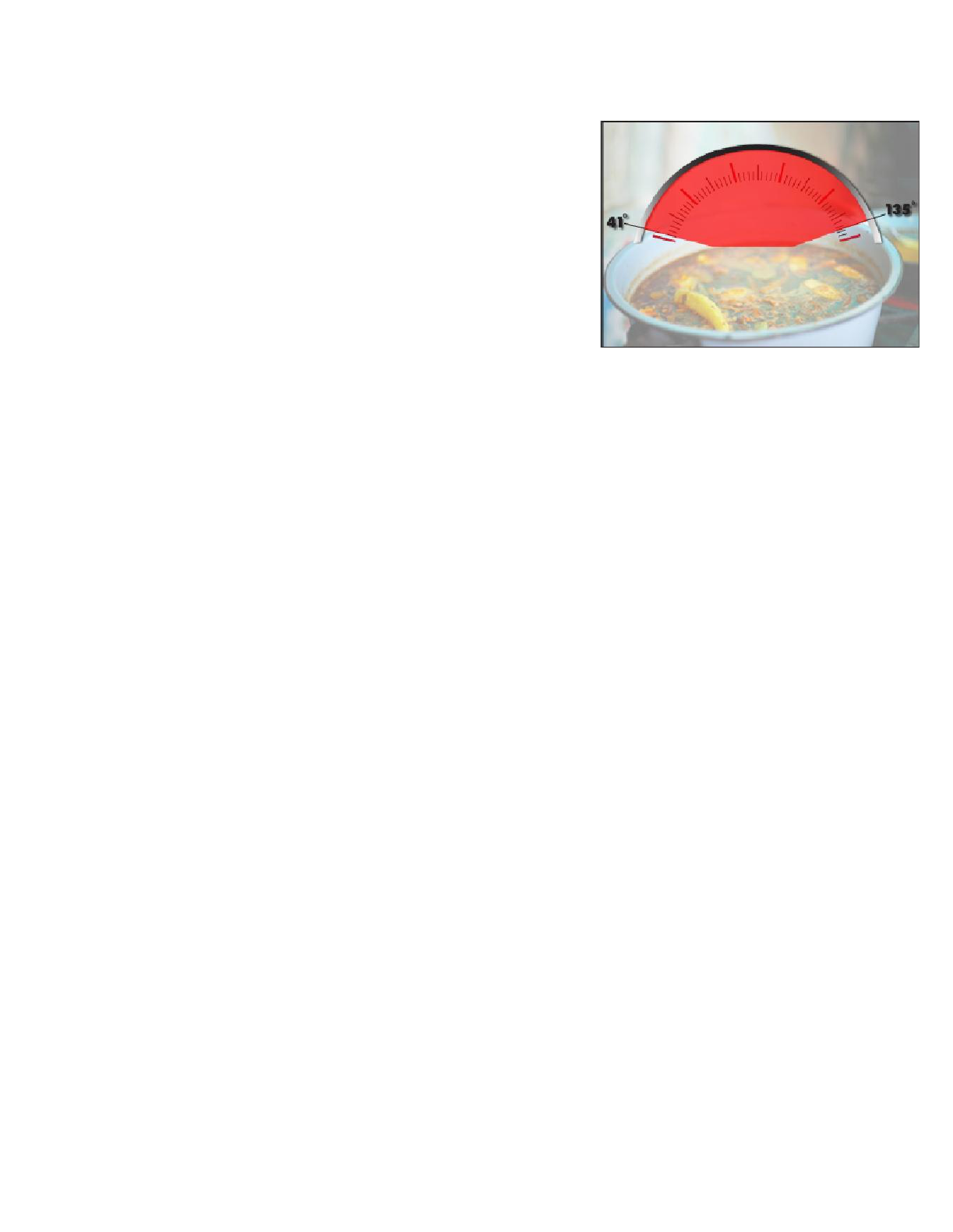
THE FLOW OF FOOD: An Introduction
AVOID TIME & TEMPERATURE ABUSE
● Monitor time and temperature – Store 41°F (5°C) and below
or 135°F (57°C) and above.
● Make sure the correct kinds of thermometers are available.
● Regularly record temperatures and the times they are taken
● Minimize the time that food spends in the temperature
danger zone
● Take corrective actions if time-temperature standards are
not met
● Separation of Raw Meat, Poultry, and Seafood from
Unwashed and Ready-to-Eat Fruits and Vegetables
○ The 2017 FDA Food Code added a requirement that raw meat, poultry, and seafood be
separated from unwashed and ready-to-eat fruits and vegetables.
○ Guidelines for Preventing Cross-Contamination between Foods
■ Separate raw meat, poultry, and seafood from unwashed and ready-to-eat fruits and
vegetables. Doing this during storage, preparation, holding, and display to prevent
THERMOMETERS
Thermometers are the most important tools managers have to prevent time-temperature abuse.
Thermometers should be washed, rinsed, sanitized, and air-dried before each use to prevent
cross-contamination. They should also be calibrated before each shift to ensure accuracy. When
measuring the internal temperatures of food, the thermometer steam or probe should be inserted into the
thickest part of the product.
● BIMETALLIC-STEMMED - the stem should be immersed in the product from the tip to the end of the
sensing area. It should have an adjustable calibration nut, be easy to read, and be accurate to within
2 degrees.
● INFRARED – measure surface temperatures and can NOT be used to take the internal
temperatures
● THERMOCOUPLES & THERMASTORS are digital with different types of probes. • Penetration
Probes - the internal temperature of food, Immersion Probes - liquids, Surface Probes - surface.
How to calibrate:
Two Methods
● Ice Method
○ Fill a large container with crushed ice and water and stir.
○ Put the thermometer stem or probe into the water. Wait till the indicator stops.
○ Adjust the thermometer so it reads 32˚F (0˚C).
● Boling Point Method
○ Bring tap water to a boil.
○ Put the thermometer stem or probe into the water.
○ Adjust the thermometer to 212˚F (100˚C).
When using thermometers:
● Wash, rinse, sanitize, and air-dry thermometers before and after using them
● Calibrate them before each shift to

ensure accuracy
● Make sure thermometers used to measure the temperature of food are accurate to
+/- 2°F or +/- 1°C
● Only use glass thermometers if they are enclosed in a shatterproof casing.

PURCHASING, STORAGE & RECEIVING
APPROVED SUPPLIER
● Has been inspected and meets all applicable local, state, and federal laws.
o Food must be purchased from approved, reputable suppliers. These suppliers have been
inspected and can show you an inspection report. They also meet all applicable local,
state, and federal laws. This applies to all suppliers in the supply chain. Your operation’s
chain can include growers, shippers, packers, manufacturers, distributors (trucking fleets
and warehouses), and local markets.
o Develop a relationship with your suppliers, and get to know their food safety practices.
Consider reviewing their most recent inspection reports. These reports can be from the
U.S. Department of Agriculture (USDA), the Food and Drug Administration (FDA), or a
third-party inspector. They should be based on Good Manufacturing Practices (GMP) or
Good Agricultural Practices (GAP).
KEY DROP-OFF DELIVERIES
Some food service operations receive food after-hours when they are closed for business. This is often
referred to as a key drop delivery. The supplier is given a key or other access to the operation to make the
delivery. Products are then placed in coolers, freezers, and dry storage areas. The delivery must be
inspected once you arrive at the operation and meet the criteria identified in the slide.
● Deliveries must meet the following criteria.
○ Be inspected upon arrival at the operation
○ Be from an approved source
○ Have been placed in the correct storage location to
maintain the required temperature
○ Have been protected from contamination in storage
○ Is NOT contaminated
○ Is honestly presented
RECEIVING
Operators must plan their delivery schedules so products can be handled promptly
and correctly. Employees assigned to receive deliveries should be trained to inspect food properly as well
as to distinguish between products that are acceptable and those that are not. Packaging should be clean
and undamaged, use-by dates current, and show no signs of mishandling.
PRODUCTS MUST BE DELIVERED AT THE PROPER TEMPERATURES .
● Cold TCS Foods – 41˚F or Lower
o Checking the Temperature of Meat, Poultry, and Fish - Insert the thermometer stem or probe
into the thickest part of the food (usually the center)
o Checking the Temperature of ROP Food (MAP, vacuum-packed, and sous vide food)- Insert
the thermometer stem or probe between 2 packages. As an alternative, fold packaging
around the thermometer stem or probe
o Checking the Temperature of Other Packaged Food - Open the package and insert the
thermometer stem or probe into the food
● Live molluscan shellfish: Receive oysters, mussels, clams, and scallops at an air temperature of
45°F (7°C) and an internal temperature no greater than 50°F (10°C).

o Once received, the shellfish must be cooled to 41°F (5°C) or lower in four hours.
o Cool the shellfish to 41°F (5°C) or lower in four hours.
● Shucked Shellfish (molluscan shellfish with both shells removed) : Receive at an internal
temperature of 45°F (7°C) or lower.
o Cool the shellfish to 41°F (5°C) or lower in four hours.
● Milk products: Receive at an internal temperature of 45°F (7°C) or lower.
o Cool the shellfish to 41°F (5°C) or lower in four hours.
● Shell On Eggs: Receive at an air temperature of 45°F (7°C) or lower.
o Cool the shellfish to 41°F (5°C) or lower in four hours.
● Hot TCS Foods 135˚F or higher
● Frozen – Frozen Solid with no Fluid Stains or Large Ice Crystals
Harvested Seafood:
● Molluscan Shellfish must be received with shell stock identification tags:
o Molluscan Shellfish Documentation & Prohibition against Commingling
The 2022 Food Code has revised the procedure for handling documentation received
with molluscan shellfish. In addition, the definition of the term “commingling” was
revised.
o Documents and Stamps
Food items must be delivered with the correct documents. For example, molluscan
shellfish must be received with a shell stock identification tag or label. These indicate
when and where the shellfish were harvested. They also ensure that the shellfish are
from an approved source.
Store molluscan shellfish (live, shucked, or in-shell product) in their original container.
Do NOT remove the shellstock tag or label from the container until the last shellfish is
used. When the last shellfish is removed from the container, write the date on the tag,
label, or invoice. Then, keep it on file, in chronological order, for 90 days from that
date.
Shellfish should remain in the container they were received in until sold or prepared for
service. Shellfish from one container should not be mixed with shellfish from another
container unless they have the same certification number or harvest date or are from
the same growing area.
o Molluscan Shellfish Clarification
▪ The 2022 Food Code now clarifies that molluscan shellfish includes shell stock (live
molluscan shellfish), shucked molluscan shellfish (shellfish with both shells removed),
and in-shell product (non-living, processed shellfish with one or both shells present.
o Molluscan Shellfish: Containers
▪ Store molluscan shellfish (live, shucked, or in-shell product) in their original container.
Do NOT remove the shellstock tag or label from the container until the last shellfish is
used. When the last shellfish is removed from the container, write the date on the tag,
label, or invoice. Then, keep it on file, in chronological order, for 90 days from that
date.
▪ Shellfish should remain in the container they were received in until sold or prepared for
service. Shellfish from one container should not be mixed with shellfish from another
container unless they have the same certification number or harvest date or are from
the same growing area.
● Fish that will be eaten raw or partially cooked
o Documentation must show the fish was correctly frozen before being received.
o Keep documents for 90 days from the sale of the fish.
● Farm-raised fish
o Must have documentation stating the fish was raised to FDA standards.

o Keep documents for 90 days from the sale of the fish
Assessing Food Quality:
● Appearance: Reject food that is moldy or has an abnormal color.
● Texture: Reject meat, fish, or poultry if:
o It is slimy, sticky, or dry
o It has soft flesh that leaves an imprint when touched
● Odor: Reject food with an abnormal or unpleasant odor
Rejecting Deliveries
● Separate rejected items from accepted items
● Tell the delivery person what is wrong with the item
● Get a signed adjustment or credit slip before giving the rejected item to the delivery person.
● Log the incident on the invoice or receiving document.
Recalls
● The manufacturer may sometimes recall food items you have received. This may happen when food
contamination is confirmed or suspected. It can also occur when items have been mislabeled or
misbranded. Often food is recalled when food allergens have not been identified on the label. Most
vendors will notify you of the recall. However, you should also monitor recall notifications made by
the FDA and the USDA. Follow the guidelines in the slide when notified of a recall.
● Identify the recalled food items by matching information from the recall notice to the item. This may
include the manufacturer’s ID, the time the item was manufactured, and the item’s use-by date.
● Remove the item from inventory, and place it in a secure and appropriate location. That may be a
cooler or dry storage area.
● The recalled item must be stored separately from food, utensils, equipment, linens, and single-use
items.
● Label the item in a way that will prevent it from being placed back in inventory. Some operations do
this by including a Do Not Use and Do Not Discard label on recalled food items. Inform staff not to
use the product.
● Refer to the vendor’s notification or recall notice for what to do with the item. For example, you might
be instructed to throw it out or return it to the vendor.
STORAGE GUIDELINES
Do not line refrigerator shelves, overload units, or open doors too often. These practices make units work
harder to maintain the temperature inside. If possible, store raw meat, poultry, and fish separately from
cooked or ready-to-eat foods to prevent cross-contamination.
If not, then store these items below cooked or ready-to-eat food. Product temperatures should be checked
regularly. Internal and external thermometers must be maintained.
● Storage shelves should be 6” inches off the floor and away from the wall for proper ventilation and
cleaning.
● Store food in containers intended for food
● Use containers that are durable, leakproof, and able to be sealed or covered
● NEVER use empty food containers to store chemicals; NEVER put food in empty chemical
containers
● Use FIFO (First In First Out) stock rotation should be followed. Store items with earlier use-by dates
in front, and use them first.
● Dry storage areas should be kept at the appropriate temperature, between 50F and 70F with a
relative humidity of 50-60%.

Items should be stored in their original packaging. If removed from its original packaging, wrap it in clean
moisture-proof material, or place it in a clean sanitized container with a tight-fitting lid. All packaging and
containers should be labeled with the
● NAME OF THE FOOD
● THE DATE PREPARED
● EXPIRATION DATE.
To prevent contamination, NEVER store food in these areas
● Locker rooms or dressing rooms
● Restrooms or garbage rooms
● Mechanical rooms
● Under unshielded sewer lines or leaking water lines
● Under stairwells
Prohibition against Storing Food, Equipment, Linens, and Single-Use Items in Empty Chemical
Containers
● Previous Food Codes have required a prohibition against storing food in containers previously used
to store chemicals. The 2022 Food Code has now expanded that prohibition to include equipment,
utensils, linens, and single-use items.
● Preventing Cross-Contamination
○ Food, equipment, utensils, linens, and single-use items must be stored in ways that prevent
cross-contamination. Follow these guidelines.
● Containers
○ NEVER use empty food containers to store chemicals. NEVER put food, equipment, utensils,
linens, or single-use items in empty chemical containers.
LABELING FOOD PACKAGED ON-SITE FOR RETAIL SALE
● Common name of the food or a statement clearly identifying it.
● Quantity of the food.
● If the item contains two or more ingredients, list the ingredients in descending order by weight.
● List of artificial colors and flavors in the food including chemical preservatives
● Name and place of business of the manufacturer, packer, or distributor.
● Source of each major food allergen contained in the food.
TCS FOODS PREPARED ON SITE must be labeled - the name of the food, and the date it should be
sold, consumed, or discarded. It can be stored for a maximum of SEVEN DAYS at 41°F (5°C) or lower
before it must be discarded.
THROW OUT ALL FOOD THAT HAS PASSED THE MANUFACTURER'S EXPIRATION DATE.
REFRIGERATORS must be set at 41°F (5°C) or lower and the thermometer placed in the warmest area.
Food stored in the following order from top to bottom to prevent cross-contamination:
1. Ready-to-eat food
2. Seafood
3. Whole cuts of beef and pork
4. Ground meat and ground fish
5. Whole and ground flying poultry
This storage order is based on the minimum internal cooking temperature of each food.

THE FLOW OF FOOD: Preparation
PREPPING FOOD:
● Only remove as much food from the cooler as you can prep in a short period of time.
o This limits time-temperature abuse
● Return prepped food to the cooler or cook it as quickly as possible.
● Make sure workstations, cutting boards, and utensils are clean and sanitized.
Food and color additives - Only use additives approved by your local regulatory authority
● NEVER use more additives than are allowed by law
● NEVER use additives to alter the appearance of food
● Do NOT sell produce treated with sulfites before it was received in the operation
● NEVER add sulfites to produce that will be eaten raw.
● Food not presented honestly must be thrown out
Four Methods for Thawing Food
● Thaw food in a cooler, keeping its temperature at 41°F (5°C) or lower
● Rapid Thawing food under running water.
o The 2022 Food Code identifies the need for the person in charge (PIC) to ensure employees
are maintaining the temperature of TCS food during thawing.
o As you know, pathogens grow well in the temperature danger zone. However, they grow
much faster at temperatures between 125°F and 70°F (52°C and 21°C). Food must pass
through this temperature range quickly to reduce this growth. That’s why it is critical to ensure
food handlers are using the correct method to cool TCS food, cooling it quickly, and regularly
monitoring temperatures during cooling.
● Thaw food in a microwave, only if cooked immediately after thawing
● Thaw as part of the cooking process
● Packaging Fish Using a Reduced Oxygen Packaging Method
o The 2017 FDA Food Code added a requirement for packaging fish using a reduced oxygen
packaging method. ServSafe addresses this as follows:
If you are packaging fish using a reduced-oxygen packaging method, the fish must:
● Be frozen before, during, or after packaging.
● Include a label that states the fish must be frozen until used.
Produce
● Make sure produce does not touch surfaces exposed to raw meat, seafood, or poultry.
● Wash it thoroughly under running water before:
o Cutting
o Cooking
o Combining it with other ingredients
● Produce can be washed in water containing ozone to sanitize it
o Check with your local regulatory authority
● When soaking or storing produce in standing water or an ice-water slurry, do NOT mix
o Different items
o Multiple batches of the same item
● Refrigerate and hold sliced melons, cut tomatoes, and cut leafy greens at 41°F (5°C) or lower
● DO NOT serve raw seed sprouts if primarily serving a high-risk population

Eggs and egg mixtures
● Handle pooled eggs (if allowed) with care:
o Cook promptly after mixing or store at 41°F (5°C) or lower
o Clean and sanitize containers between batches
● Consider using pasteurized shell eggs or egg products when prepping dishes that need little or no
cooking
● Eggs, Juice and Milk have pasteurization in common.
Ice:
● NEVER use ice as an ingredient if it was used to keep food cold
● Transfer ice using clean and sanitized containers and scoops
● NEVER hold ice in containers that hold chemicals or raw meat, seafood, or poultry
● Store ice scoops outside ice machines in a clean, protected location
● NEVER use a glass to scoop ice or touch ice with hands.
Variance Requirements for Special Processes
The 2017 FDA Food Code added a requirement to submit an HACCP plan when applying for a variance to
prepare food in specific ways.
When applying for a variance, your regulatory authority may require you to submit a HACCP plan.
● The HACCP plan must account for any food safety risks related to the way you plan to prep the food
item.
● You must comply with the HACCP plan and procedures submitted.
● You must maintain the HACCP plan and any other associated documents—including the
variance—at the operation.
● These documents must be provided to the regulatory authority if requested.
● Your records must show that you have procedures for monitoring critical control points and are:
○ Regularly monitoring the critical control points.
○ Taking the necessary corrective actions if there is a failure at a critical control point.
○ Verifying the effectiveness of the processes or procedures.
● A variance is required when:
● Sushi Rice.
● Packaging fresh juice on-site for sale at a later time, unless the juice has a warning label
● Smoking food to preserve it (but not to enhance flavor)
● Using food additives or components to preserve or alter food so it no longer needs time and
temperature control for safety
● Curing food
● Custom-processing animals for personal use (e.g., dressing a deer)
● Packaging food using a reduced-oxygen packaging (ROP) & MAP Packaging method
● Sous Vide
● Sprouting seeds or beans
● Offering live shellfish from a display tank
SAFE TIME AND INTERNAL TEMPATURE REQUIRMENTS

165˚F (74˚C) for <1 second (Instantaneous)
o Poultry—whole or ground chicken, turkey or duck
o Stuffing made with fish, meat, or poultry
o Stuffed meat, seafood, poultry, or pasta
o Dishes that include previously cooked TCS ingredients (raw ingredients should be cooked to
their required minimum internal temperatures)
o Animal proteins cooked in the microwave
155˚F (68˚C) for 17 seconds
o Ground meat—beef, pork, and other meat
o Injected meat—including brined ham and flavor-injected roasts
o Mechanically tenderized meat - “ Cubed Meat” and “Pounded Meat” as Non-Intact Meat
o Ground meat from game animals commercially raised and inspected
o Ratites - (mostly flightless birds with flat breastbones) including ostrich and emu
o Ground seafood—including chopped or minced seafood
o Shell eggs that will be hot-held for service
145˚F (63˚C) for 15 seconds
o Seafood—including fish, shellfish, and crustaceans
o Steaks/chops of pork, beef, veal, and lamb
o Commercially raised game
o Shell eggs that will be served immediately
145˚F (63˚C) for four minutes
o Roasts of pork, beef, veal, and lamb
o Alternate cooking times/temperatures
130˚F(54˚C) 112 minutes
131˚F(55˚C) 89 minutes
133˚F(56˚C) 56 minute
135˚F(57˚C) 36 minutes
136˚F(58˚C) 28 minutes
138˚F(59˚C) 18 minutes
140˚F(60˚C) 12 minutes
142˚F(61˚C) 8 minutes
144˚F(62˚C) 5 minutes
135˚F (57˚C)
o Fruit, vegetables, grains (rice, pasta), and legumes (beans, refried beans) that will be
hot-held for service
If any of these items are cooked below the suggested internal cooking temperature you need to have on
the menu a disclaimer noted to let the guest know they are consuming under cooked foods.
Requirement to Follow Manufacturer Cooking Instructions
● The 2022 Food Code adds a new requirement that foods received with manufacturer cooking
instructions must be cooked according to those instructions.
○ Manufacturer Cooking Instructions
■ Some packaged foods contain manufacturer’s instructions for cooking. These
instructions must be followed before using the product. Frozen vegetables are an
example. They frequently contain cooking instructions from the manufacturer and are
often intended for use only after cooking. It is especially important to follow these
instructions when using frozen vegetables to make RTE foods, such as salads. If the
vegetables contained a pathogen and the food was not cooked, the pathogen could
multiply and cause foodborne illness.

Prohibition against Serving Food Not Cooked According to Manufacturer Instructions to High-Risk
Populations
● The 2022 Food Code adds “foods not cooked according to manufacturer cooking instructions” to the
list of foods prohibited to be served to highly susceptible populations.
○ Operations That Mainly Serve High-Risk Populations
■ Operations that mainly serve a high-risk population, such as nursing homes or daycare
centers, cannot serve certain items. NEVER serve these items:
● Packaged food, such as frozen vegetables, that have not been cooked
according to manufacturer’s instructions.
Partial Cooking During Preparation - If partially cooking meat, seafood, poultry, or eggs or dishes
containing these items:
A. Never cook the food longer than 60 minutes during initial cooking.
B. Cool the food immediately after initial cooking.
C. Freeze or refrigerate the food after cooling it.
D. Finish cooking to the original cooking temperature before selling or serving it.
E. Cool the food if it will not be served immediately or held for service.
COOLING TCS FOODS - Never place hot food in refrigerators, which could raise the temperature inside.
You have a total of 4 Hours to cool food.
Step 1 - Cool food from 135˚F and above to 70˚F in the first two hours
Step 2 – Cool food from 70˚F to 41˚F in 4 hours
Use the methods:
● Cut larger items into smaller pieces
● Divide large containers of food into smaller containers or shallow pans
● Place food in an ice-water bath
● Stir it with an ice paddle
● Place it in a blast chiller
Food Reheated for Immediate Service
● Can be reheated to any temperature if it was cooked and cooled correctly
Food Reheated for Hot-Holding
● Must be reheated to an internal temperature of 165°F (74°C) for 15 seconds within 2 hours
● Reheat commercially processed and packaged ready-to-eat food to an internal temperature of at
least 135°F (57°C)

THE FLOW OF FOOD: Service
Guidelines for Holding Food
● Cover food and install sneeze guards to protect food from contaminants. Covers protect food from
contamination and help maintain food temperatures.
● Hold TCS food at the right temperature
o Hot food: 135°F (57°C) or higher
o Cold food: 41°F (5°C) or lower
● Check temperatures at least every 4 hours
o Throw out food not at 41°F (5°C) or lower
o Check temperatures every 2 hours to leave time for corrective action
● NEVER use hot-holding equipment to reheat food unless it’s designed for it
o Reheat food correctly, and then move it into a holding unit
Holding Food Without Temperature Control
● The 2017 FDA Food Code added requirements for displaying or holding ready-to-eat TCS food
without temperature control. The Supplement to the 2017 FDA Food Code added alternatives to the
requirements for holding cold ready-to-eat TCS food without temperature control.
● Holding Food without Temperature Control
○ If your operation displays or holds TCS food without temperature control, it must do so under
certain conditions. This includes:
○ Preparing written procedures and getting written approval in advance by the regulatory
authority. • Maintaining those procedures in the operation.
○ Making sure those procedures are made available to the regulatory authority on request.
○ Other conditions may apply. Also, note that the conditions for holding cold food are different
from those for holding hot food. Before using time as a method of control, check with your
local regulatory authority for specific requirements.
Cold Food can be held without temperature control
● You can hold cold food without temperature control for up to six hours if you meet these conditions:
○ Hold the food at 41°F (5°C) or lower before removing it from refrigeration.
○ Label the food with the time you removed it from refrigeration and the time you must throw it
out. The discard time on the label must be six hours from the time you removed the food from
refrigeration. For example, if you remove potato salad from refrigeration at 3:00 p.m. to serve
at a picnic, the discard time on the label should be 9:00 p.m. This equals six hours from the
time you removed it from refrigeration.
○ Make sure the food temperature does not exceed 70°F (21°C) while it is being served. Throw
out any food that exceeds this temperature.
○ Sell, serve, or throw out the food within six hours.
● There are alternatives to these requirements for holding cold TCS food that is ready to eat without
temperature control.
○ If the food is discarded within four hours, it can be allowed to reach any temperature during
service.
○ The food must be held at 41°F (5°C) or lower before removing it from temperature control.

○ The discard time on the label must be four hours from the time the food was removed from
temperature control.
○ The food must be sold, served, or thrown out within four hours.
● Ready-to-eat fruit or vegetables that become a TCS food when cut, chopped, or sliced and
hermetically sealed containers of food that become a TCS food when opened, like a can of tuna,
can have an initial temperature of 70°F (21°C) or lower.
○ The product must be discarded within four hours.
○ The temperature of the product cannot exceed 70°F (21°C) within the four-hour period.
○ The discard time on the label must be four hours from the time when the product became a
TCS food.
Hot food can be held without temperature control for up to 4 hours
● Before using time as a method of control, check with your local regulatory authority for specific
requirements.
● For hot food, the discard time on the label must be four hours from the time you removed the food
from temperature control.
Kitchen Staff Guidelines for Serving Food
● Store serving utensils correctly between uses
o On a clean and sanitized food-contact surface
o In the food with the handle extended above the container rim
● Store serving utensils correctly between uses
o On a clean and sanitized food-contact surface
o In the food with the handle extended above the container rim
GLASSWARE AND DISHES should be held at the base or from underneath, and not be stacked when
serving.
FLATWARE AND UTENSILS should be stored handles up and in the same direction in a drawer or
storage container.
RE-SERVING – Only unopened individually packaged condiments are okay to re-serve. Plate garnish,
bread, or open dishes of condiments can never be served to a new guest.
NEVER re-serve:
● Food returned by one customer to another customer
● Uncovered condiments
● Uneaten bread
● Plate garnishes
Generally, only unopened, prepackaged food in good condition can be re-served:
● Condiment packets
● Wrapped crackers or breadsticks
SELF SERVICE AREAS - Never allow customers to re-use soiled or dirty plates . Protect food in food
bars and buffets with sneeze guards and make sure equipment can hold food at the proper temperature.
Keep raw foods away from ready-to-eat or cooked foods and label all food items.
Prevent time-temperature abuse and contamination continued

● Keep hot food at 135°F (57°C) or higher
● Keep cold food at 41°F (5°C) or lower
● Keep raw meat, fish, and poultry separate from ready-to-eat food
● Do NOT let customers refill dirty plates or use dirty utensils at self-service areas
● Stock food displays with the correct utensils for dispensing food.
● Do NOT use ice as an ingredient if it was used to keep food or beverages cold
Labeling Bulk Food in Self-Service Areas
● Make sure the label is in plain view of the customer
● Include the manufacturer or processor label provided with the food
● As an alternative provide the information using a card, sign, or other labeling method
● A label is not needed for bulk unpackaged food, such as bakery products, if:
o The product makes no claim regarding health or nutrient content
o No laws requiring labeling exist
o The food is manufactured or prepared on the premises
o The food is manufactured or prepared at another regulated food operation or processing
plant owned by the same person
OFF SITE SERVICE
● Use insulated, food-grade containers designed to stop food from mixing, leaking, or spilling
● Clean the inside of delivery vehicles regularly
● Check internal food temperatures
● Label food with a use-by date and time, and reheating and service instructions
● Make sure the service site has the correct utilities
o Safe water for cooking, dishwashing, and hand washing
o Garbage containers stored away from food-prep, storage, and serving areas
o Store raw meat, poultry, and seafood, and ready-to-eat items separately
VENDING MACHINES
• Handle food prepped and packaged for vending machines with the same care as any other food
served to customers. Vending operators should protect food from contamination and
time-temperature abuse during transport, delivery, and service.
• Check product shelf life daily. Products often have a code date, such as expiration or a use-by date.
If the date has expired, throw out the food immediately. Throw out refrigerated food prepped on-site
if not sold within seven days of preparation.
• Keep TCS food at the correct temperature. It should be held at 41°F (5°C) or lower, or at 135°F
(57°C) or higher. These machines must have controls that prevent TCS food from being dispensed if
the temperature stays in the danger zone for a specified amount of time. This food must be thrown
out.

FOOD SAFETY MANAGEMENT SYSTEMS
PREREQUISITE PROGRAMS
Programs for personal hygiene, facility design, supplier selection, sanitation and pest control, equipment
maintenance, and food safety training must be in place before attempting either of the food safety
management systems
ACTIVE MANAGERIAL CONTROL.
This approach focuses on controlling the five most common risk factors responsible for foodborne illness
identified by the CDC. These include purchasing from unsafe sources, failing to cook adequately, holding
food at improper temperatures, using contaminated equipment, and practicing poor personal hygiene.
1. Identify and document potential risks and ways to control or eliminate them.
2. Monitor critical activities.
3. Correct improper procedures or behaviors.
4. Verify that policies, procedures, and corrective actions are followed.
5. Ensure employees are trained and retrained as needed.
6. Periodically assess the system to make sure it is working.
HAZARD ANALYSIS CRITICAL CONTROL POINT (HACCP)
The HACCP system focuses on identifying specific points where it is essential to prevent eliminate or
reduce biological, chemical, or physical hazards to a safe level.
Hazard analysis and critical control points, or HACCP is a systematic preventive approach to food
safety and pharmaceutical safety that addresses physical, chemical, and biological hazards as a means of
prevention rather than finished product inspection. HACCP is used in the food industry to identify potential
food safety hazards so that key actions can be taken to reduce or eliminate the risk of the hazards being
realized. The system is used at all stages of food production and preparation processes including
packaging, distribution, etc. The Food and Drug Administration (FDA) and the United States Department of
Agriculture (USDA) say that their mandatory HACCP programs for juice and meat are an effective
approach to food safety and protecting public health. Meat HACCP systems are regulated by the USDA,
while seafood and juice are regulated by the FDA. The use of HACCP is currently voluntary in other food
industries.
7 Steps of HACCP
1. Conduct a Hazard Analysis
2. Determine the critical control points where the hazards can be prevented, eliminated or reduced to
safe levels
3. Determine and establish maximum and minimum limits that must be met for each Critical Control
Point (CCP)
4. Determine and establish monitoring procedures
5. Identify what corrective actions will be taken when critical limits have not been met
6. Verify that your plan is working
7. Establish procedures for record-keeping and documentation

SANITRARY FACILITIES, EQUIPMENT, and PEST MANAGEMENT
FLOORING
Should be strong, durable, and easy to clean. It should also be non-absorbent, resist wear, and help
prevent slips, especially in walk-ins, food prep areas, dishwashing areas, restrooms, and other areas
subject to moisture or spray cleaning. Carpeting is not recommended in high-soil areas but is popular in
dining rooms because it absorbs sounds.
● COVING is a curved, sealed edge placed between the floor and the wall and is used to
eliminate sharp corners or gaps or cracks between the floor and the wall that would make it
impossible to clean.
RESTROOMS / HANDWASHING STATIONS
Restrooms should be cleaned regularly and have a fully equipped hand washing station with hot & cold
water , soap, a means to dry hands, a waste container, and signage indicating employees hand washing
requirements before returning to work. Hand washing stations should be accessible and convenient to
make hand washing easy.
● Required Water Temperature at Handwashing Sinks
○ The 2022 Food Code has now revised the water temperature requirement at a handwashing
sink. Water is now required to be supplied through a mixing valve or combination faucet at a
temperature of at least 85°F (29°C).
○ Running Water - The water must be supplied through a mixing valve or combination faucet
that delivers the water at a temperature of at least 85°F (29°C). The water must also be
drinkable (potable water).
Requirement to Locate Break Areas to Prevent Contamination
● The 2022 Food Code has expanded the definition of smoking to include “using tobacco products” in
break areas.
○ Break Areas
■ Areas designated for employees to eat, drink, chew gum, and use tobacco products
must be carefully located to protect food, equipment, linens, and single-use items from
contamination.
FOOD SERVICE GRADE EQUIPMENT STANDARDS
Foodservice equipment must meet specific standards if it will come in contact with food, such as being
smooth, easy to clean, durable, and resistant to damage. Organizations such as NSF International have
developed standards like these for the sanitary design and construction of food service equipment. They
also certify equipment that meets these standards. Other organizations classify equipment—or evaluate it
to ensure that it meets the standards developed by others.
These organizations must be accredited by the ANSI National Accreditation Board (ANAB), which is a
wholly-owned subsidiary of the American National Standards Institute (ANSI), a nonprofit corporation.
When purchasing equipment, look for the NSF mark, the UL EPH classified mark, or the ETL sanitation
mark. These indicate that the equipment has been certified or classified for sanitation under an
ANAB-accredited program.
Only commercial food service equipment should be used in operations. Household equipment is not built to
withstand heavy use.

STATIONARY EQUIPMENT
Must be mounted on legs at least six inches off the floor, or it must be sealed to a masonry base .
Stationary tabletop equipment should be mounted on legs with a clearance of four inches between the
tabletop and the equipment or it should be sealed to the tabletop. This is for cleaning purposes.
POTABLE WATER (Drinkable Water)
Potable water safe to drink is vital in an establishment. Sources include public water mains, private water
sources that are tested at least once a year, and bottled drinking water. In a water emergency, an
establishment might be allowed to remain open if certain precautions are followed. These could include
boiling water or purchasing water, boiling water for hand washing, and essential tasks.
PLUMBING
Only licensed plumbers should install and maintain plumbing systems. The greatest challenge to water
safety comes from cross-connections is a physical link through which contaminants from drains, sewers,
and other wastewater sources can flow into the potable water supply. Vacuum breakers and air gaps can
be used to prevent backflow.
LIGHTING
Lighting intensity is measured in foot candles
● At least 108 lux (10-foot candles): Walk-in refrigerators, Dry food storage areas, Other rooms,
and areas during cleaning
● At least 215 lux (20-foot candles): Self- Service displays such as buffets and salad bars,
Fresh produce displays, Inside equipment such as reach-in and under-counter refrigerators,
handwashing, ware washing, and equipment/utensil storing areas, Bathrooms
● At least 540 lux (50-foot candles): All food preparation area
SHATTER-RESISTANT BULBS AND PROTECTIVE COVERS prevent broken glass from
contaminating food.
ADEQUATE VENTILATION
Adequate Ventilation improves indoor air quality by removing smoke, grease, steam, and heat . If there is
adequate ventilation, there will be no buildup of grease and condensation on walls and ceilings .
Ventilation must be designed so hoods, fans, guards, and ductwork do not drip onto food or equipment.
Hood filters and grease extractors must be cleaned regularly by a licensed and bonded professional.
GARBAGE & TALLOW CONTAINERS
Must be leakproof, waterproof, pest-proof, easy to clean, and durable. They must have tight-fitting lids and
must be kept covered when not in use. All garbage containers should be frequently cleaned thoroughly
both inside and out. Garbage should be removed from food-preparation areas as soon as possible, and
must not be carried across a food-preparation area.
CLEANING AND SANITIZING
The 2017 FDA Food Code added a requirement to make cleaners & sanitizers available to employees
during all hours of operation.
● CLEANING is the process of removing food and other types of soil from a surface. To properly clean
you must use a soap and water solution.
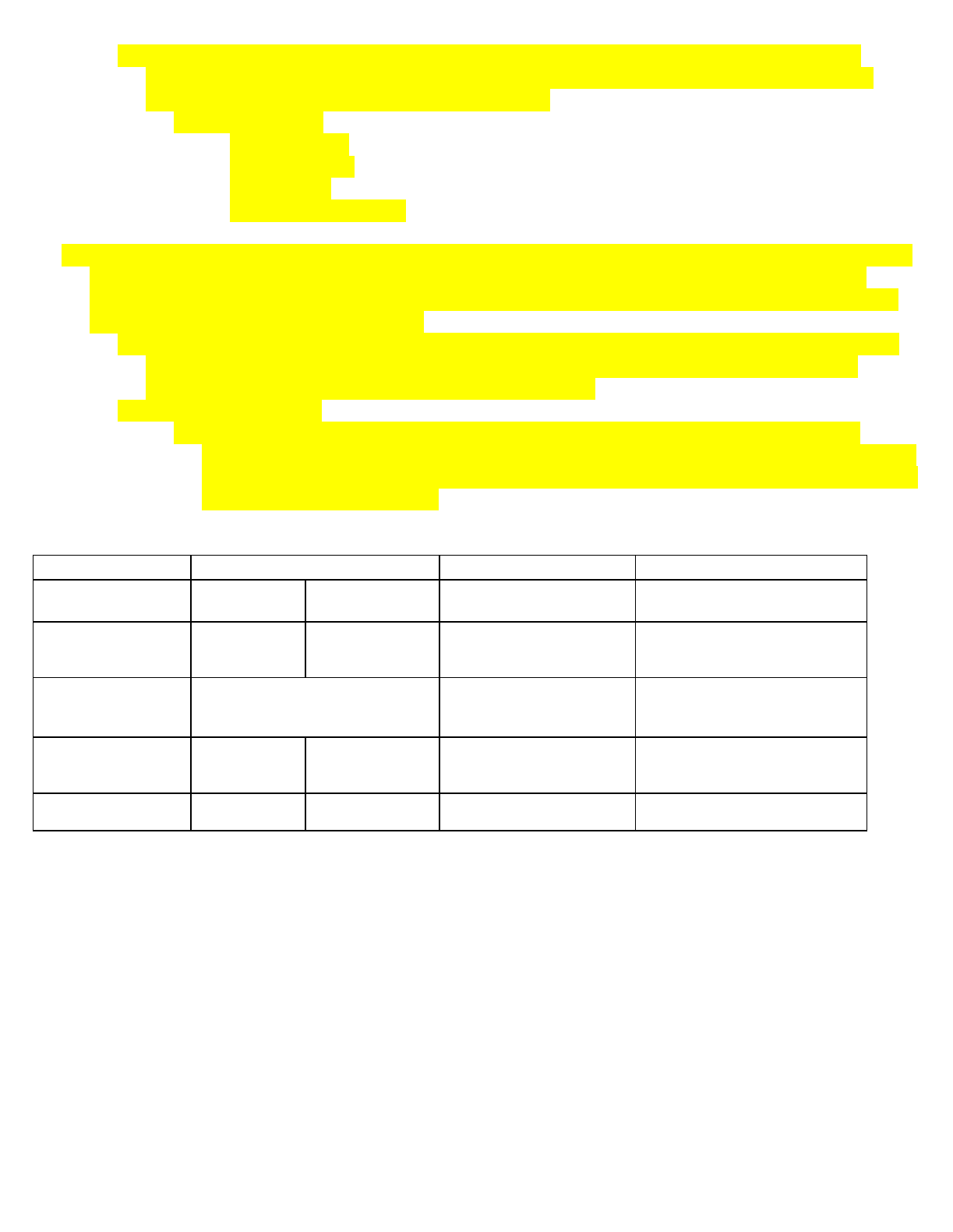
○ Cleaners - Cleaners must be stable, noncorrosive, and safe to use. They must also be
provided and available to employees during all hours of operation . There are a variety of
cleaners available, each with a different purpose.
■ These include:
● Detergents
● Degreasers
● Delimers
● Abrasive cleaners
● SANITIZING is the process of reducing the number of harmful microorganisms from a clean surface
to safe levels. You must clean and rinse a surface before you sanitize. Chemical sanitizers are
influenced by contact time, concentration of the sanitizer, and temperature of the solution. Test the
solution regularly with a sanitizer test kit.
○ All surfaces must be cleaned and rinsed. This includes walls, storage shelves, and garbage
containers. However, any surface that touches food, such as knives, stockpots, cutting
boards, or prep tables, must be cleaned and sanitized.
○ Chemical Sanitizing
■ Three common types of chemical sanitizers are chlorine, iodine, and quaternary
ammonium compounds (quats). Chemical sanitizers are regulated by state and federal
environmental protection agencies. They must be provided and available to employees
during all hours of operation.
Chlorine
Iodine
Quats
Water
temperature
≥ 100°F (38°C)
≥ 75°F (24°C)
68°F (20°C)
75°F (24°C)
Water pH
≤ 10
≤ 8
≤ 5 or as per
manufacturer's
recommendation
As per manufacturer's
recommendation
Water hardness
As per manufacturer's
recommendation
As per manufacturer's
recommendation
500 ppm or as per
manufacturer's
recommendation
Sanitizer
concentration
range
50-99 ppm
50-99 ppm
12.5-25 ppm
As per manufacturer's
recommendation
Sanitizer contact
time
≥ 7 sec
≥ 7 sec
≥ 30 sec
≥ 30 sec
5 Step Process
1. Scrape or remove food bits from the surface. Use the correct cleaning tool such as a nylon brush or
pad, or a cloth towel.
2. Wash the surface. Prepare the cleaning solution with an approved detergent. Wash the surface with
the correct cleaning tool such as a cloth towel.
3. Rinse the surface. Use clean water. Rinse the surface with the correct cleaning tool such as a cloth
towel.
4. Sanitize the surface. Use the correct sanitizing solution. Prepare the concentration per manufacturer
requirements. Use the correct tool, such as a cloth towel, to sanitize the surface. Make sure the
entire surface has come in contact with the sanitizing solution.
5. Allow the surface to air dry.
Availability of Cleaners & Sanitizers

The 2017 FDA Food Code added a requirement to make cleaners & sanitizers available to employees
during all hours of operation.
● Cleaners - Cleaners must be stable, noncorrosive, and safe to use. They must also be provided and
available to employees during all hours of operation . There are a variety of cleaners available, each
with a different purpose.
○ These include:
■ Detergents
■ Degreasers
■ Delimers
■ Abrasive cleaners
● Chemical Sanitizing
○ Three common types of chemical sanitizers are chlorine, iodine, and quaternary ammonium
compounds (quats). Chemical sanitizers are regulated by state and federal environmental
protection agencies. They must be provided and available to employees during all hours of
operation.
DISHWASHING MACHINES
Follow the manufacturer's guidelines and make sure your machine is clean and in good working condition.
Check the temperature and pressure of wash and rinse cycles daily. Information should be posted on the
machine regarding proper water temperature, conveyor speed, water pressure, and chemical
concentration.
High-Temperature Machines
● Final sanitizing rinse must be at least 180°F (82°C)
● 165°F (74°C) for a stationary rack, single-temperature machines
Chemical-Sanitizing Machines
● Clean and sanitize at much lower temperatures
● Follow the temperature guidelines provided by the manufacturer
THREE-COMPARTMENT SINK
Items cleaned in the three compartment sink should be pre-soaked or scrapped clean, washed in detergent
with 110F water, rinsed in clean water, and sanitized in either hot water at least 171F or a
chemical-sanitizing solution . All items should be air-dried inverted .
CLEANING TOOLS AND CHEMICALS
Cleaning Tools and Chemicals should be placed in a storage area away from food and food-preparation
areas. Make sure chemicals are clearly labeled if removed from the original container. Keep Safety Data
Sheets (SDS) for each chemical in a location for all employees on the job. These sheets have important
first aid information and information about safe use. Dispose of chemicals according to the instructions on
the label and local regulations. It is the employee’s right to know what they are working with and around.
MASTER CLEANING SCHEDULE
Lists all cleaning tasks, as well as when and how tasks should be completed. Assign responsibility to each
task by job title. Create employee support by including their input into the program design and rewarding
good performance. Monitor the cleaning program to keep it effective.
INTEGRATED PEST MANAGEMENT (IPM)
Must address these issues to be an effective IPM program

● DENY PEST ACCESS
● DENY PESTS FOOD
● SHELTER AND WATER
● WORK WITH A LICENSED PEST CONTROL OPERATOR (PCO) to eliminate any pests that enter.
ROACHES like dark, warm moist places. Check for a strong oily smell, droppings look like grains of
black pepper , and capsule egg cases.
RODENTS are also a serious health hazard. A building can be infested with both rats and mice at the
same time. Look for droppings, signs of gnawing, tracks, nesting materials, and holes.
FLIES can carry Shigellosis and typhoid fever.
PESTICIDES are hazardous materials. Anytime they are used or stored on your premises, you must have
a corresponding MSDS . To minimize the hazard to people, have your PCO use pesticides when you are
closed and your employees are not on site. Be sure to wash rinse and sanitize food contact surfaces after
a treatment.
